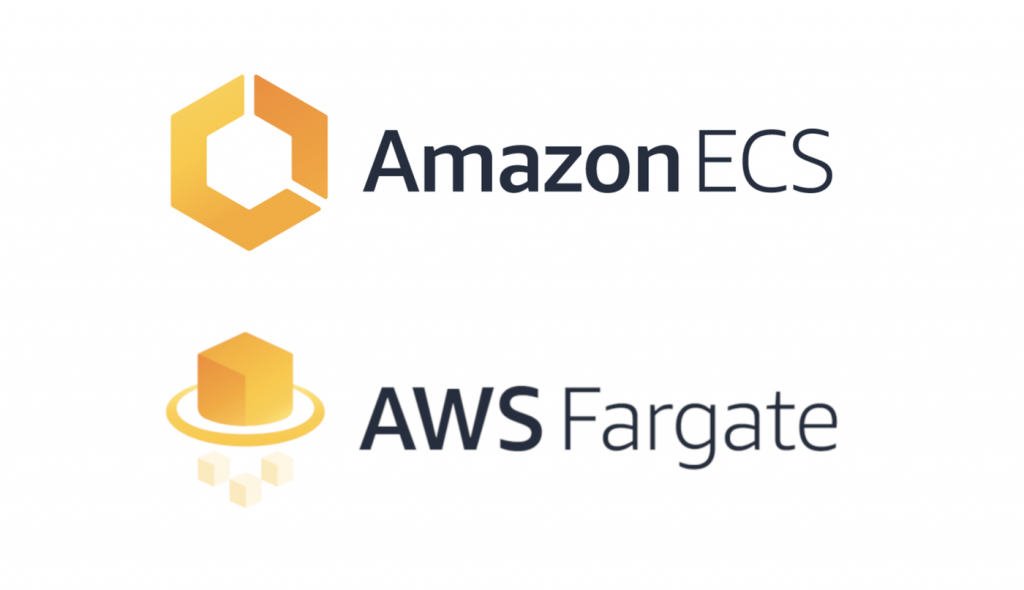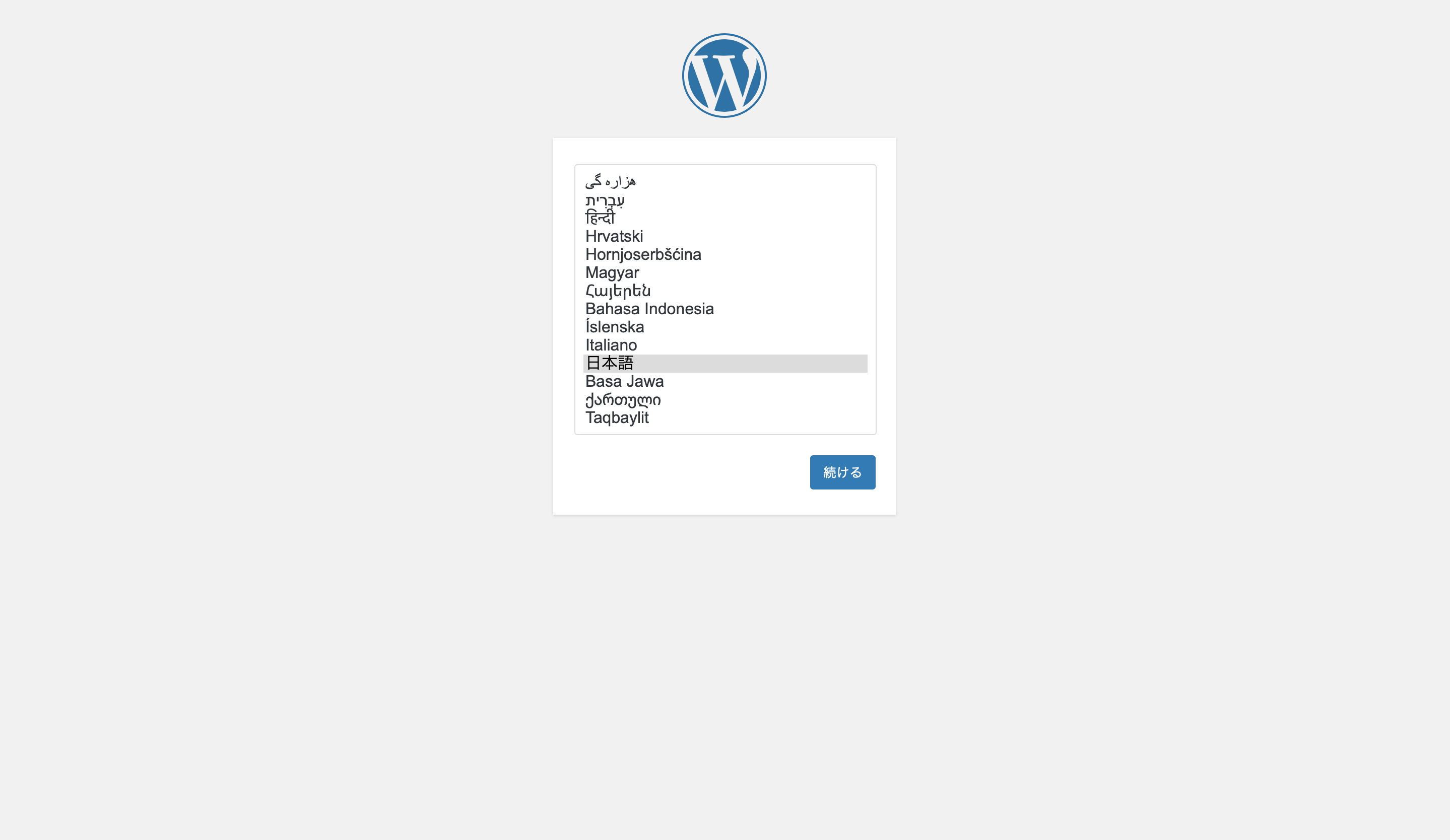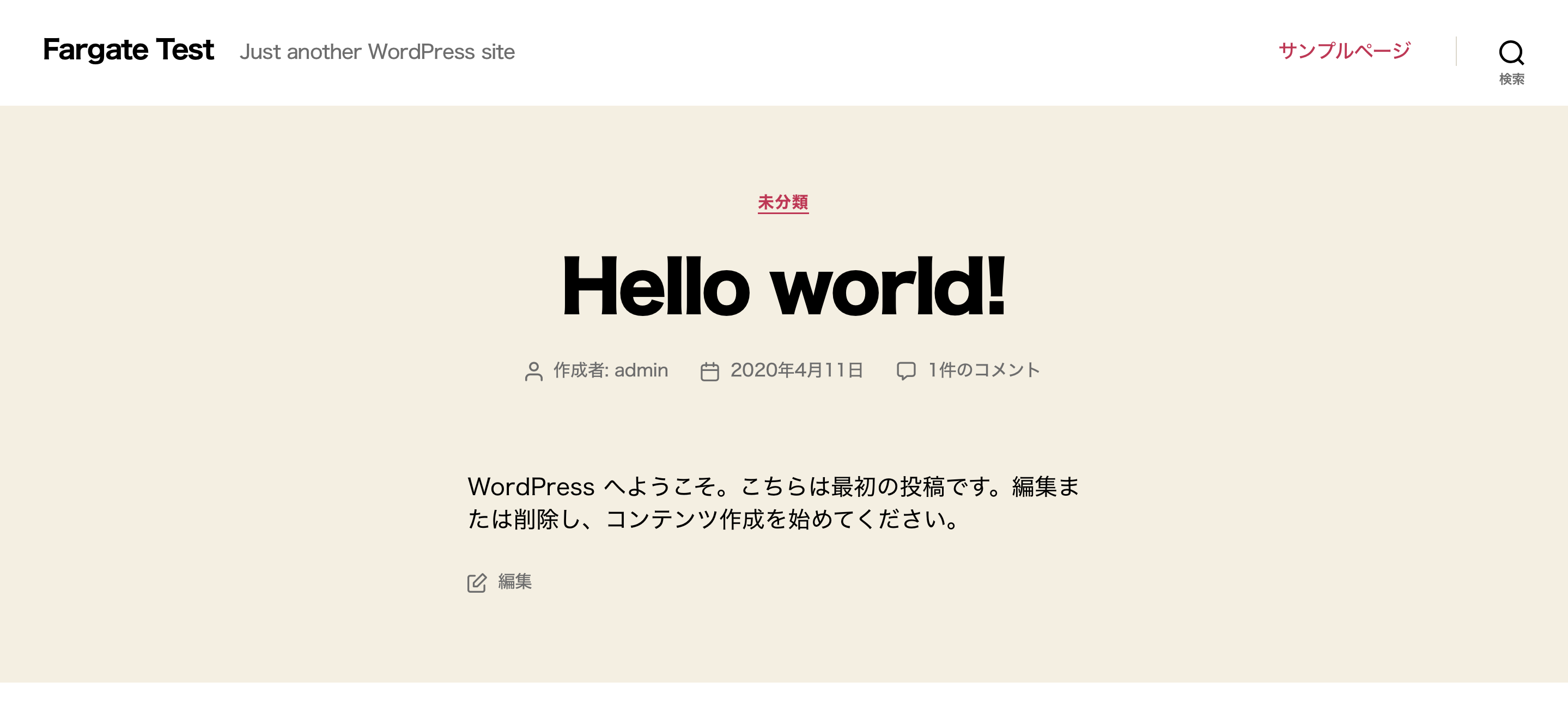Now that Fargate supports EFS, build your WordPress environment with Terraform

table of contents
My name is Teraoka and I am an infrastructure engineer.
AWS has a service called "Amazon ECS", and there are two startup modes: "Amazon EC2" and "AWS Fargate".
Fargate is a fully managed container execution environment provided by AWS, which is very convenient as it eliminates the need for cluster management. However, due to its specifications, it is not possible to mount persistent volumes on containers, The storage will be deleted at the same time as the service is stopped.
When the WordPress tested this time is started in a container, all images used in posted articles will be saved to the local volume, so it would be a problem if the storage was deleted.
If you still want to use Fargate because it's convenient, we have good news for you.
Fargate started supporting EFS endpoints starting with platform version 1.4.
● AWS Fargate releases platform version 1.4
With this, it seems possible to share data between containers while retaining persistent data.
I actually tried it.
The configuration tested this time
If you follow the instructions in this article, you will end up with a configuration like this:
All construction is done using Terraform, so the code is written below.
Terraform version is "0.12.24".
Please be careful when using it as a reference.
the code I wrote
The directory structure is below.
$ tree . ├── README.md ├── alb.tf ├── efs.tf ├── fargate.tf ├── iam.tf ├── provider.tf ├── rds.tf ├── roles │ ├── fargate_task_assume_role.json │ └── fargate_task_execution_policy.json ├── securitygroup.tf ├── ssm.tf ├── tasks │ └── container_definitions.json ├── terraform.tfstate ├── terraform.tfstate.backup ├── variables.tf └── vpc.tf 2 directories, 16 files
provider.tf
provider "aws" { access_key = var.access_key secret_key = var.secret_key region = var.region assume_role { role_arn = var.role_arn } }
variables.tf
#################### # Provider #################### variable "access_key" { description = " AWS Access Key" } variable "secret_key" { description = "AWS Secret Key" } variable "role_arn" { description = "AWS Role Arn" } variable "region" { default = "ap-northeast-1" }
vpc.tf
#################### # VPC #################### resource "aws_vpc" "vpc" { cidr_block = "10.0.0.0/16" enable_dns_support = true enable_dns_hostnames = true tags = { Name = "vpc-fargate-efs" } } #################### # Subnet #################### resource "aws_subnet" "public_1a" { vpc_id = aws_vpc.vpc.id availability_zone = "${var.region}a" cidr_block = " 10.0.10.0/24" map_public_ip_on_launch = true tags = { Name = "subnet-fargate-efs-public-1a" } } resource "aws_subnet" "public_1c" { vpc_id = aws_vpc.vpc.id availability_zone = "${var.region }c" cidr_block = "10.0.11.0/24" map_public_ip_on_launch = true tags = { Name = "subnet-fargate-efs-public-1c" } } resource "aws_subnet" "dmz_1a" { vpc_id = aws_vpc.vpc.id availability_zone = "${var.region}a" cidr_block = "10.0.20.0/24" map_public_ip_on_launch = true tags = { Name = "subnet-fargate-efs-dmz-1a" } } resource "aws_subnet" "dmz_1c" { vpc_id = aws_vpc .vpc.id availability_zone = "${var.region}c" cidr_block = "10.0.21.0/24" map_public_ip_on_launch = true tags = { Name = "subnet-fargate-efs-dmz-1c" } } resource "aws_subnet" " private_1a" { vpc_id = aws_vpc.vpc.id availability_zone = "${var.region}a" cidr_block = "10.0.30.0/24" map_public_ip_on_launch = true tags = { Name = "subnet-fargate-efs-private-1a" } } resource "aws_subnet" "private_1c" { vpc_id = aws_vpc.vpc.id availability_zone = "${var.region}c" cidr_block = "10.0.31.0/24" map_public_ip_on_launch = true tags = { Name = "subnet-fargate-efs -private-1c" } } ################### # Route Table #################### resource "aws_route_table" "public" { vpc_id = aws_vpc.vpc.id tags = { Name = "route-fargate-efs-public" } } resource "aws_route_table" "dmz" { vpc_id = aws_vpc.vpc.id tags = { Name = "route-fargate-efs-dmz" } } resource "aws_route_table" "private" { vpc_id = aws_vpc.vpc.id tags = { Name = "route-fargate-efs-private" } } ####### ############# # IGW ################### resource "aws_internet_gateway" "igw" { vpc_id = aws_vpc.vpc.id tags = { Name = "igw-fargate-efs" } } #################### # NATGW ############## ###### resource "aws_eip" "natgw" { vpc = true tags = { Name = "natgw-fargate-efs" } } resource "aws_nat_gateway" "natgw" { allocation_id = aws_eip.natgw.id subnet_id = aws_subnet. public_1a.id tags = { Name = "natgw-fargate-efs" } depends_on = [aws_internet_gateway.igw] } #################### # Route #### ################ resource "aws_route" "public" { route_table_id = aws_route_table.public.id destination_cidr_block = "0.0.0.0/0" gateway_id = aws_internet_gateway.igw.id depends_on = [ aws_route_table.public] } resource "aws_route" "dmz" { route_table_id = aws_route_table.dmz.id destination_cidr_block = "0.0.0.0/0" nat_gateway_id = aws_nat_gateway.natgw.id depends_on = [aws_route_table.dmz] } ###### ############## # Route Association ################### resource "aws_route_table_association" "public_1a" { subnet_id = aws_subnet.public_1a .id route_table_id = aws_route_table.public.id } resource "aws_route_table_association" "public_1c" { subnet_id = aws_subnet.public_1c.id route_table_id = aws_route_table.public.id } resource "aws_route_table_association" "dmz_1a" { subnet_id = aws_subnet.dmz_1a .id route_table_id = aws_route_table.dmz.id } resource "aws_route_table_association" "dmz_1c" { subnet_id = aws_subnet.dmz_1c.id route_table_id = aws_route_table.dmz.id } resource "aws_route_table_association" "private_1a" { subnet_id = aws_subnet.private_1a. id route_table_id = aws_route_table.private. id } resource "aws_route_table_association" "private_1c" { subnet_id = aws_subnet.private_1c.id route_table_id = aws_route_table.private.id }
securitygroup.tf
#################### # Security Group #################### resource "aws_security_group" "alb" { name = "alb-sg" description = "for ALB" vpc_id = aws_vpc.vpc.id } resource "aws_security_group" "fargate" { name = "fargate-sg" description = "for Fargate" vpc_id = aws_vpc.vpc.id } resource "aws_security_group" "efs" { name = "efs-sg" description = "for EFS" vpc_id = aws_vpc.vpc.id } resource "aws_security_group" "rds" { name = "rds-sg" description = "for RDS " vpc_id = aws_vpc.vpc.id } ##################### # Security Group Rule ################ ##### resource "aws_security_group_rule" "allow_http_for_alb" { security_group_id = aws_security_group.alb.id type = "ingress" protocol = "tcp" from_port = 80 to_port = 80 cidr_blocks = ["0.0.0.0/0"] description = " allow_http_for_alb" } resource "aws_security_group_rule" "from_alb_to_fargate" { security_group_id = aws_security_group.fargate.id type = "ingress" protocol = "tcp" from_port = 80 to_port = 80 source_security_group_id = aws_security_group.alb.id description = "from_alb_to_fargate" } resource "aws_security_group_ rule " "from_fargate_to_efs" { security_group_id = aws_security_group.efs.id type = "ingress" protocol = "tcp" from_port = 2049 to_port = 2049 source_security_group_id = aws_security_group.fargate.id description = "from_fargate_to_efs" } resource "aws_security_group_rule" "from_fargate_to_rds" { security_group _id = aws_security_group.rds.id type = "ingress" protocol = "tcp" from_port = 3306 to_port = 3306 source_security_group_id = aws_security_group.fargate.id description = "from_fargate_to_rds" } resource "aws_security_group_rule" "egress_alb" { security_group_id = aws_security_group.alb.id type = "egress" protocol = "-1" from_port = 0 to_port = 0 cidr_blocks = ["0.0.0.0/0"] description = "Outbound ALL" } resource "aws_security_group_rule" "egress_fargate" { security_group_id = aws_security_group.fargate.id type = "egress" protocol = "-1" from_port = 0 to_port = 0 cidr_blocks = ["0.0.0.0/0"] description = "Outbound ALL" } resource "aws_security_group_rule" "egress_efs" { security_group_id = aws_security_group.efs.id type = "egress" protocol = "-1" from_port = 0 to_port = 0 cidr_blocks = ["0.0.0.0/0"] description = "Outbound ALL" } resource "aws_security_group_rule" "egress_rds" { security_group_id = aws_security_group.rds.id type = "egress" protocol = "-1" from_port = 0 to_port = 0 cidr_blocks = ["0.0.0.0/0"] description = "Outbound ALL" }
alb.tf
#################### # ALB #################### resource "aws_lb" "alb" { name = "alb-fargate-efs" internal = false load_balancer_type = "application" security_groups = [ aws_security_group.alb.id ] subnets = [ aws_subnet.public_1a.id, aws_subnet.public_1c.id ] } ######## ############ # Target Group ################### resource "aws_lb_target_group" "alb" { name = "fargate-efs- tg" port = "80" protocol = "HTTP" target_type = "ip" vpc_id = aws_vpc.vpc.id deregistration_delay = "60" health_check { interval = "10" path = "/" port = "traffic-port" protocol = "HTTP" timeout = "4" healthy_threshold = "2" unhealthy_threshold = "10" matcher = "200-302" } } #################### # Listener # ################### resource "aws_lb_listener" "alb" { load_balancer_arn = aws_lb.alb.arn port = "80" protocol = "HTTP" default_action { type = "forward " target_group_arn = aws_lb_target_group.alb.arn } }
efs.tf
#################### # EFS #################### resource "aws_efs_file_system" "efs" { creation_token = "fargate-efs" provisioned_throughput_in_mibps = "50" throughput_mode = "provisioned" tags = { Name = "fargate-efs" } } #################### # Mount Target #################### resource "aws_efs_mount_target" "dmz_1a" { file_system_id = aws_efs_file_system.efs.id subnet_id = aws_subnet.dmz_1a.id security_groups = [ aws_security_group.efs .id ] } resource "aws_efs_mount_target" "dmz_1c" { file_system_id = aws_efs_file_system.efs.id subnet_id = aws_subnet.dmz_1c.id security_groups = [ aws_security_group.efs.id ] }
rds.tf
#################### # Parameter Group #################### resource "aws_db_parameter_group" "rds" { name = "fargate-efs-pg" family = "mysql5.7" description = "for RDS" } #################### # Subnet Group ### ################# resource "aws_db_subnet_group" "rds" { name = "fargate-efs-sg" description = "for RDS" subnet_ids = [ aws_subnet.private_1a.id, aws_subnet .private_1c.id ] } ################### # Instance #################### resource " aws_db_instance" "rds" { identifier = "fargate-efs-db01" engine = "mysql" engine_version = "5.7" instance_class = "db.t3.micro" storage_type = "gp2" allocated_storage = "50" max_allocated_storage = "100" username = "root" password = "password" final_snapshot_identifier = "fargate-efs-db01-final" db_subnet_group_name = aws_db_subnet_group.rds.name parameter_group_name = aws_db_parameter_group.rds.name multi_az = false vpc_security_group_ids = [ aws_security_group.rds.id ] backup_retention_period = "7 " apply_immediately = true }
fargate.tf
#################### # Cluster #################### resource "aws_ecs_cluster" "cluster" { name = "cluster-fargate-efs" setting { name = "containerInsights" value = "disabled" } } #################### # Task Definition #### ################ resource "aws_ecs_task_definition" "task" { family = "task-fargate-wordpress" container_definitions = file("tasks/container_definitions.json") cpu = "256" memory = "512" network_mode = "awsvpc" execution_role_arn = aws_iam_role.fargate_task_execution.arn volume { name = "fargate-efs" efs_volume_configuration { file_system_id = aws_efs_file_system.efs.id root_directory = "/" } } requires_compatibilities = [ "FARGATE" ] } #################### # Service #################### resource "aws_ecs_service" "service" { name = "service-fargate-efs" cluster = aws_ecs_cluster.cluster.arn task_definition = aws_ecs_task_definition.task.arn desired_count = 2 launch_type = "FARGATE" platform_version = "1.4.0" load_balancer { target_group_arn = aws_lb_target_group.alb.arn container_name = " wordpress" container_port = "80" } network_configuration { subnets = [ aws_subnet.dmz_1a.id, aws_subnet.dmz_1c.id ] security_groups = [ aws_security_group.fargate.id ] assign_public_ip = false } }
container_definition.json
[ { "name": "wordpress", "image": "wordpress:latest", "essential": true, "portMappings": [ { "containerPort": 80, "hostPort": 80 } ], "mountPoints": [ { "containerPath": "/var/www/html", "sourceVolume": "fargate-efs" } ], "secrets": [ { "name": "WORDPRESS_DB_HOST", "valueFrom": "WORDPRESS_DB_HOST" }, { "name": "WORDPRESS_DB_USER", "valueFrom": "WORDPRESS_DB_USER" }, { "name": "WORDPRESS_DB_PASSWORD", "valueFrom": "WORDPRESS_DB_PASSWORD" }, { "name": "WORDPRESS_DB_NAME", "valueFrom": " WORDPRESS_DB_NAME" } ] } ]
iam.tf
#################### # IAM Role #################### resource "aws_iam_role" "fargate_task_execution" { name = "role-fargate_task_execution" assume_role_policy = file("./roles/fargate_task_assume_role.json") } #################### # IAM Role Policy ### ################# resource "aws_iam_role_policy" "fargate_task_execution" { name = "execution-policy" role = aws_iam_role.fargate_task_execution.name policy = file("./roles/fargate_task_execution_policy. json") }
fargate_task_assume_role.json
{ "Version": "2012-10-17", "Statement": [ { "Effect": "Allow", "Principal": { "Service": "ecs-tasks.amazonaws.com" }, "Action" : "sts:AssumeRole" } ] }
fargate_task_execution_policy.json
{ "Version": "2012-10-17", "Statement": [ { "Effect": "Allow", "Action": "ssm:GetParameters", "Resource": "*" } ] }
ssm.tf
#################### # Parameter #################### resource "aws_ssm_parameter" "wordpress_db_host" { name = "WORDPRESS_DB_HOST" description = "WORDPRESS_DB_HOST" type = "String" value = aws_db_instance.rds.address } resource "aws_ssm_parameter" "wordpress_db_user" { name = "WORDPRESS_DB_USER" description = "WORDPRESS_DB_USER" type = "String" value = "wordpress " } resource "aws_ssm_parameter" "wordpress_db_password" { name = "WORDPRESS_DB_PASSWORD" description = "WORDPRESS_DB_PASSWORD" type = "String" value = "password" } resource "aws_ssm_parameter" "wordpress_db_name" { name = "WORDPRESS_DB_NAME" description = "WORDPRESS_DB_NAME" type = "String" value = "wordpress" }
Initial configuration of RDS
Let's create a database and user for WordPress.
$ create database wordpress; $ CREATE USER 'wordpress'@'%' IDENTIFIED WITH mysql_native_password BY 'password'; $ grant all privileges on wordpress.* to wordpress@'%';
Operation confirmation
After running terraform apply, two Fargate tasks will be launched, so access the ALB endpoint.

The WordPress screen will be displayed, and after performing the initial settings, the site will be displayed as shown below.
So far, it hasn't been a problem.

Now on to the main topic, let's post an article with an image from the management screen.

When you press the post button, you will be redirected to the article page, and then press the F5 key repeatedly to update it.

If EFS is not recognized correctly, the image may or may not be displayed depending on the screen reload, but after reloading the screen about 100 times, the display did not change. It seems okay.
summary
The ability to work with Fargate and EFS greatly expands the design possibilities when building.
Platform version 1.4 includes many other useful updates, so why not give it a try?

 1
1








